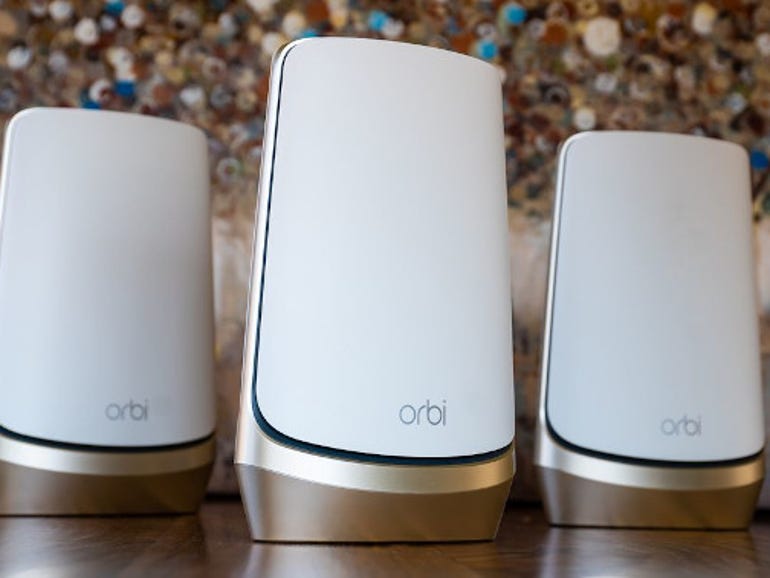- I tested a Pixel Tablet without any Google apps, and it's more private than even my iPad
- My search for the best MacBook docking station is over. This one can power it all
- This $500 Motorola proves you don't need to spend more on flagship phones
- Finally, budget wireless earbuds that I wouldn't mind putting my AirPods away for
- I replaced my Linux system with this $200 Windows mini PC - and it left me impressed
Netgear Orbi Wi-Fi 6E: The fastest and most expensive Wi-Fi you can buy | ZDNet

Netgear’s Orbi Wi-Fi 6E
, aka AXE11000 or RBKE963, mesh Wi-Fi router hardware is expensive with a capital E. It currently costs a cool $1,500 for the router and its two satellites. But, for that money, you’ll get the fastest Wi-Fi networking you’ve ever seen.
How fast is it? I used the Ixia’s IxChariot networking benchmark and my
Galaxy S21 Ultra smartphone
to measure its throughput and it beat every other Wi-Fi network I’ve ever tested. And, friends, I’ve tested a lot of network gear in my day.
For example, for years now Wi-Fi router companies have been claiming they could break the 1 gigabit per second (Gbps) barrier. Spoiler alert: None of them could. Until now. This new model Orbi cracked the speed barrier at 20-feet with traffic just over 1 Gbps. Color me impressed.
Of course, at further distances, its speed dropped. But even at 50 to 150 feet I still saw speeds in the 200 Megabit per second (Mbps) to 100 Mbps range. That’s still darn good.
Better still, I was seeing these speeds, not across empty space but through the walls and floors of my two building home: A century-old, two-story historic house with thick Wi-Fi unfriendly walls and a brand two-story new office and studio. Together they cover approximately 4,000 square feet and I got good connections from one end of my property to the other. Good luck getting that to work with other Wi-Fi hardware.
In addition, my home/office has dozens of computers, half-a-dozen tablets, three smart TVs, and a host of other networked connections. In short, my network gets a real workout. And, the Orbi kept it all running without a moment of trouble.
Netgear claims theAXE11000 can cover up to 9,000 square feet and connect up to 250 devices. I see no reason to doubt their claims.
To really get the most from the Orbi AXE11000, though, you need to have the internet bandwidth to feed its need for speed. With a 1 Gbps internet feeding a 10 Gbps wired network, I’ve got that. But, if all you have is say a 300 Mbps connection to the world and older hardware, you’ll be wasting your money with the Orbi.
For example, the reason I finally and consistently got a Gigabit of speed from my Wi-Fi is I was able to use the AXE11000’s support for the new short-range 6GHz 6E band. But, if your equipment can’t support 6E, say with an
Intel Wi-Fi 6E AX210 (Gig+) adapter
, you’ll never see 6E speed. And there are few computers and smartphones which currently support it.
If you have a great internet connection, you may want to pay the money to upgrade your PCs and other gear to 6E. For instance, 6E can deliver sub-five-millisecond latency. It’s a gamer’s dream come true.
But, even without 6E compliant hardware, the AXE11000 still delivers the bandwidth you crave. That’s because, as Netgear aptly puts it, the world’s first quad-band Wi-Fi mesh router. Besides the commonplace 2.4 and 5GHz bands we all know and use, it comes with a second 5GHz band for backhaul transmissions, and 6E’s new 6GHz band. That backhaul wireless connection is great for delivering 4K video, for example, to otherwise distant Roku streaming devices and the like.
Or, if you have a small business you’ll appreciate that it can support three separate Wi-Fi networks: A 2.4-GHz network, a 5-GHz network, and the new 6-GHz network. A backhaul network is also present and used exclusively for connecting with the satellite units.
Making all this work, each separate Wi-Fi unit comes with a dozen amplified antennas for the best possible signal. This is all powered by Qualcomm’s best-of-breed Networking Pro 1610 chipset and a 2.2GHz ARM quad-core processor. Each unit also comes with a GB of RAM and 512MBs of storage for firmware, software, and settings.
Combine all this with 802.11ax networking and 4K Quadrature Amplitude Modulation (QAM) and you get both great speed and the invisible automatic ability to beamform your signals to make the best possible connection with your hardware. This means you can have up to 16 independent streams of data for the best possible, interruption-less connections.
For when I really need speed, I still use wired Ethernet and the AXE11000 delivers here as well. Each device includes a 2.5Gbps LAN port with three additional gigabit Ethernet jacks. In addition, the router’s WAN port supports incoming speeds of up to 10Gbps. Too fast to ever be useful? Think again, we’ll have 10Gbps Internet soon enough.
So, is the AXE11000 for everyone? Heck, no! It’s too expensive and overkill for most users. But, if you’re running a small business, are a serious gamer, or, someone like me, who really can use all the network speed and range he can get, then the AXE11000 is a great investment.
Related Stories:

